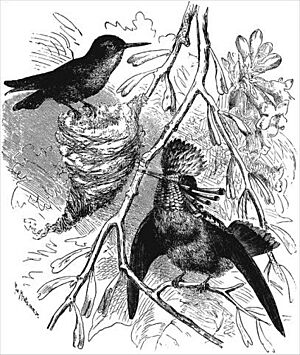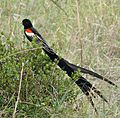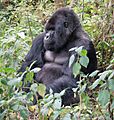Sexual selection facts for kids
Sexual selection is a special type of natural selection. It's a big idea from Charles Darwin that helps explain why some animals have amazing features. These features help them find a mate. It's all about competition within a species to reproduce.
Darwin explained that sexual selection happens when individuals of one sex, usually males, compete for the chance to mate with the other sex. This often means males fighting each other. Features like horns or antlers, which help in these fights, are called 'weapons'. Other features, like bright feathers, that help attract a mate are called 'ornaments'.
Often, females choose males who have impressive ornaments or who are strong fighters. Scientists think that males who can grow big ornaments or fight well might have better health or be stronger overall. This idea is called the 'good genes' hypothesis. Sexual selection is still a topic that scientists study and discuss a lot today.
Contents
Darwin's Big Idea
Charles Darwin first wrote about sexual selection in his book The Descent of Man, and Selection in Relation to Sex (1871). He noticed that some animal features seemed strange because they didn't help with survival. For example, bright colors could make an animal easier for predators to spot.
However, Darwin saw that these features did something else important: they helped animals find a mate. This could happen in two ways:
- By helping an animal compete with others of the same sex (like two males fighting).
- By helping an animal attract a mate from the opposite sex (like a male showing off to a female).
How Sexual Selection Works
Sexual selection happens in different ways. Let's look at the two main types.
Competition Within One Sex
This type of selection is called intrasexual selection. It means competition happens within the same sex.
- What it is: Members of one sex, usually males, compete with each other to get access to the other sex.
- Favored features: Animals develop features that help them win these competitions. These include:
- Weapons like antlers, horns, or a large body size.
- Aggressive behaviors, such as fighting or showing off their territory.
- Examples:
- Male elephant seals fight fiercely for control over groups of females.
- Stag beetles use their large mandibles (jaws) to wrestle with other males.
Choosing a Mate
This type of selection is called intersexual selection. It means one sex chooses mates based on certain features.
- What it is: One sex, often females, chooses their mates based on traits they find attractive or desirable.
- Favored features: Animals develop features that help them get chosen. These include:
- Ornaments like bright feathers or fancy dances.
- Signs of good genes, such as a healthy appearance or symmetry (being perfectly balanced).
- Examples:
- Female peahens pick peacocks with the biggest and most colorful tails.
- Bowerbirds build amazing, decorated nests to impress females.
Why Traits Become Exaggerated
Have you ever wondered why some animals have such extreme features, like a peacock's huge tail? Sexual selection can lead to these exaggerated traits for a few reasons:
- Showing off fitness: Some traits, like a peacock’s tail, are very costly to grow and maintain. Only the strongest and healthiest individuals can afford to have such a "handicap." This shows potential mates that they have good genes and are strong.
- Runaway selection: If females start to prefer a certain trait, like a long tail, then males with longer tails will get more mates. Over many generations, this preference can make the trait become more and more extreme. It's like a "runaway" process.
- Signs of health: Certain traits, such as bright colors, can show that an animal is healthy and doesn't have many parasites. Females choose these males because they want their offspring to inherit strong, healthy genes.
Related pages
Images for kids
-
Sexual selection creates colorful differences between sexes in Goldie's bird-of-paradise. Male above; female below. Painting by John Gerrard Keulemans
-
Male mountain gorilla, a species with very large males.
-
Protarchaeopteryx was flightless but had feathers, perhaps used in courtship, that helped it later develop flight.
-
Males of many spiders, such as this Phidippus putnami, have elaborate courtship displays.
-
Each firefly species attracts mates with its own flash pattern.
-
Male Dendropsophus microcephalus calling.
-
Male Victoria's riflebird displaying to a female.
-
A male satin bowerbird guards its bower from rival males, hoping to attract females with its decorations.
-
Male southern elephant seals fighting on Macquarie Island for the right to mate.
-
Citronella flower's symmetry may have been subject to sexual selection by its pollinators.
See also
 In Spanish: Selección sexual para niños
In Spanish: Selección sexual para niños


















